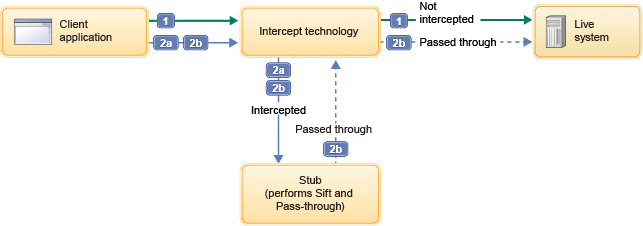Sift-and-pass-through capability
You can filter the messages that a stub receives, separating traffic from client and server applications that need to use the live system as opposed to a virtual system.
In HCL OneTest™ API:
- Traffic from HTTP, IBM® WebSphere® MQ, CICS® , IMS™, Java™ , MQ telemetry or WebMethods Integration Server transports can be routed to a stub by examining data in the traffic on an exact matching basis.
- Logic can be added to a stub to enable it to determine whether
it should respond to a received request (sifting) or, when
possible, send the traffic for onward processing to the real system
(pass-through).Note: Currently, this sift-and-pass-through capability cannot be used with other transports supported by HCL OneTest™ API.
- Any HTTP header filters associated with the operation are applied
before messages are passed to the sift-and-pass-through capability.
For more information, see Filtering header values.Note: When using a stub in sift-and-pass-through mode, only the new messages are processed. Existing messages on the queue are not processed.

- Route 1 (green): The client application sends traffic addressed to the live system. The intercept technology decides not to intercept the traffic, so it continues to the live system. If the message type is request/response, then the live system sends a response (not shown on diagram).
- Route 2a (solid blue): The client application sends traffic addressed to the live system. The intercept technology decides to intercept it and sends it to the stub. The stub is either not performing sift and pass-through, or it examines the message and accepts it. If the message type is request/response, then the stub sends a response (not shown on diagram).
- Route 2b (solid blue & dashed blue): The client application sends traffic addressed to the live system. The intercept technology decides to intercept it and sends it to the stub. The stub is performing sift and pass-through, examines the traffic and rejects it, passing it back to the intercept technology, which passes it on to the live system. If the message type is request/response, then the live system sends a response (not shown on diagram).
The following topics describe how to use the sift-and-pass-through capability.